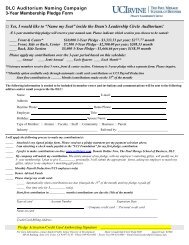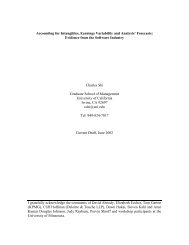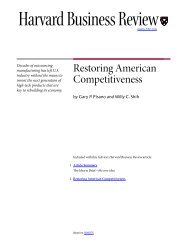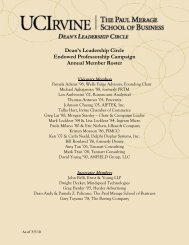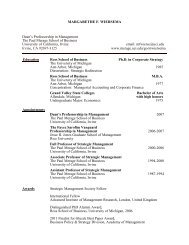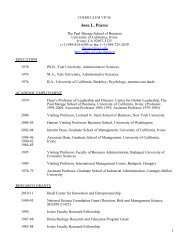View Carlson-Titman-Tiu Paper - The Paul Merage School of Business
View Carlson-Titman-Tiu Paper - The Paul Merage School of Business
View Carlson-Titman-Tiu Paper - The Paul Merage School of Business
You also want an ePaper? Increase the reach of your titles
YUMPU automatically turns print PDFs into web optimized ePapers that Google loves.
Proposition 2 Denote by<br />
With these notations:<br />
12<br />
a(r) := σr(r) ˆ φ ′ 1 (r)<br />
ˆφ1(r)<br />
. (14)<br />
dRR t = r eq<br />
t dt + σLdW L t + a(r eq<br />
t dW r <br />
t<br />
dR P t = r ∗ dt + σLdW L t .<br />
<strong>The</strong> conditional correlation (r) = corr dR P t , dR R t | r eq<br />
t = r /dt is then given by:<br />
(15)<br />
<br />
(r) = <br />
σL + ρa(r)<br />
σ2 L + a(r)2 . (16)<br />
+ 2ρσLa(r)<br />
Figure 5 presents the correlations when the public discount rate takes different values. At times<br />
when conversions occur, REITs and private real estate are perfectly correlated, and consequently<br />
there is no additional diversification benefits from holding both types <strong>of</strong> assets simultaneously.<br />
However, the correlation decreases to around 0.75 in the middle <strong>of</strong> the no-conversion interval.<br />
4 Marking-to-Market: Issues and Solutions<br />
REITs and real estate share the common cash flow component, Lt, but differ in price due to<br />
differences in required rates <strong>of</strong> return. As shown in the equilibrium <strong>of</strong> Section 3, the difference<br />
between private and public discount rates is a stationary process. This implies that REIT prices<br />
will contain pertinent information for real estate valuation, and in particular for marking to market.<br />
We begin by showing in general how REIT prices relate to private values. Let vi t = ln V i<br />
<br />
t for<br />
i ∈ {P, R}. <strong>The</strong>n<br />
v P t = lt + Φ<br />
= lt + Φt + (Φt − Φ)<br />
= v R t + ηt,<br />
where lt = ln(Lt), Φt = ln(φt) with φt = φ R (rt), Φ = ln[(r ∗ − µL) −1 ], and ηt = Φt − Φ. <strong>The</strong><br />
equilibrium produces a well-defined unconditional distribution <strong>of</strong> ηt. Under parameterizations <strong>of</strong><br />
the model in which the mean <strong>of</strong> ηt is small, equation (17) shows that log REIT values will provide<br />
estimates <strong>of</strong> log private values that are approximately unbiased in an unconditional sense. Marking<br />
(17)






